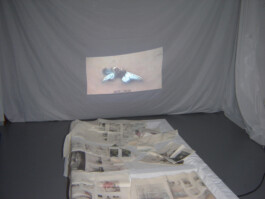


La Habitación (2022)
pine wood, cotton, sound and moving images.
The title of this multimedia installation represents the most intimate place in which individuality is hidden, it is the place where the body and mind rest and in turn coexist with their memories. In this sense the artist is interested in the Heideggerian term about dwelling, which refers to «staying, residing, sheltering and caring». A bed is the central element of this installation, it is the essence of a bed, its skeleton and structure are covered by sheets, which were sheets that belonged to the artist's grandmother, whom she never met cause of she passed away before she was born. These sheets represent the memory that has been told, the memory that remains in time.
Another element that makes up the installation is the fabric with transferred images, which function as sculptural components. These pieces reference domestic textiles like rags, towels, or even clothing. The wrinkles created simply by leaving them on the bed also produce creases in the images. Symbolically, they evoke memories of home, as the images themselves are photographs of details from the artist's childhood house. Light is another important element, present both within the installation and in the audiovisual details, such as in the shots where glimpses of sunlight can be seen.



La Habitación (2022)
pine wood, cotton, sound and moving images.
The title of this multimedia installation represents the most intimate place in which individuality is hidden, it is the place where the body and mind rest and in turn coexist with their memories. In this sense the artist is interested in the Heideggerian term about dwelling, which refers to «staying, residing, sheltering and caring». A bed is the central element of this installation, it is the essence of a bed, its skeleton and structure are covered by sheets, which were sheets that belonged to the artist's grandmother, whom she never met cause of she passed away before she was born. These sheets represent the memory that has been told, the memory that remains in time.
Another element that makes up the installation is the fabric with transferred images, which function as sculptural components. These pieces reference domestic textiles like rags, towels, or even clothing. The wrinkles created simply by leaving them on the bed also produce creases in the images. Symbolically, they evoke memories of home, as the images themselves are photographs of details from the artist's childhood house. Light is another important element, present both within the installation and in the audiovisual details, such as in the shots where glimpses of sunlight can be seen.